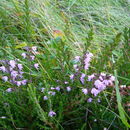Biology
provided by Arkive
Heather flowers from July to September (4); the flowers are pollinated by insects and by the wind (2). This plant has been put to various practical uses; it has been used as fodder, fuel, thatch, bedding for livestock and humans, a packing material, and to make ropes, brooms, an orange dye, and beer. White heather is thought to be lucky, especially in Scotland (5).
Conservation
provided by Arkive
Most remaining heathland/ moorland is in the uplands; these heaths are used for sheep grazing and grouse management; many such areas are now in agri-environment schemes to help maintain heather cover (6).
Description
provided by Arkive
Heather is a highly branched evergreen shrub. The numerous stems take root at the base, and there are also a large number of short side shoots (2). The leaves are very small and scale-like, their sides are often curled back so much that they are triangular in cross-section (2). The small reddish-purple flowers are borne on narrow spikes (4). Shrubs typically grow to around 60cm in height, but may occasionally reach 1 m (2).
Habitat
provided by Arkive
This species typically dominates heaths, moors, bogs and grasslands, which are poor in nutrients. It also grows in acidic soils in open woodland, and can tolerate a range of moisture levels, from wet peat bogs to exposed and dry areas (3). It reaches altitudes of 750 m (2).
Range
provided by Arkive
Found throughout much of the British Isles, but is less widespread in the East Midlands (2). Elsewhere, heather is found in most of western Europe, reaching as far north as Scandinavia, but becomes scarce in parts of the Mediterranean. It also occurs in west Asia and North Africa, and has been introduced to North America and Chile (2).
Status
provided by Arkive
Widespread (3).
Threats
provided by Arkive
The amount of habitat suitable for heather has been reduced drastically since 1950, especially in England. This decline was due to a loss of heathland through forestry, scrub growth, agricultural expansion, and mineral workings (3). Furthermore, in many upland areas, prolonged overgrazing has caused a loss of heather, which cannot survive periods of excessive grazing pressure (3). The greatest losses of heathland have been in the south of England; as much as three-quarters of the original heathlands have been lost in Dorset and the Breckland in the 20th century (5).

